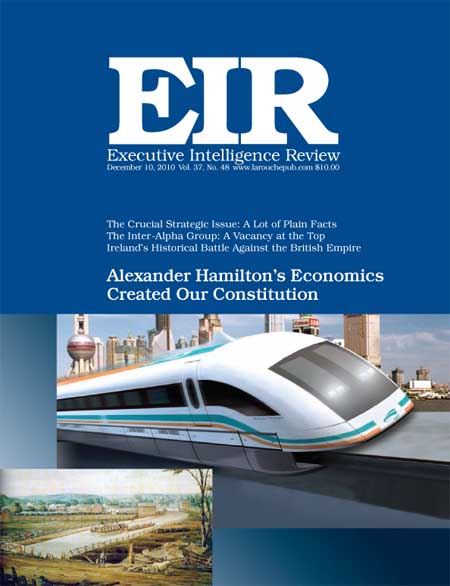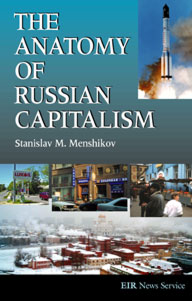|
.
|
|
|
|
 |
|
|
Dec. 6—Contrary to the views of nearly all economic experts, there is a simple reality which thinking Americans must face in the midst of this unprecedented breakdown of the financial and physical economy: First, that the key to reversing this global crisis, which threatens civilization itself, can be found in the principle behind the economic measures of America's first Treasury Secretary, Alexander Hamilton. Second, that that principle is firmly embedded in the U.S. Constitution itself.
There will be those who yell and scream about this assertion. Both Wall Street financiers and unwashed populists will insist that Hamilton was an elitist who copied the British System, and that his institution of national banking and government promotion of manufactures and internal improvements was a violation of the free-trade system which has supposedly been responsible for our prosperity as a nation. But, they lie. For Hamilton was the intellectual author of the U.S. Constitution itself, and its unique principle of using a credit system, based on national sovereignty, to foster capital formation for technological progress.
Hamilton's genius in economics was evident from almost immediately after he came to America's shores in 1772. By 1774, he was already writing anti-British tracts which contained the germ of the concept of national physical economy... |
|
|
|
|
|
|
|
|
March 23, 2007
—EIR News Service announced the publication of
The Anatomy of Russian Capitalism,
by Professor Stanislav M. Menshikov.
Translated from the Russian by Rachel Douglas, the book is an authoritative study of the Russian economy during the first 15 years after the break-up of the Soviet Union. The Preface, by EIR founder and contributing editor Lyndon LaRouche, titled, "Russia's Next Step," poses the need for U.S. policy-makers to study and grasp the "disease" presented in this book, since it represents "an economic global pandemic which we must all join to defeat." |
|
This Week's Cover
- A Matter of Principle:
Alexander Hamilton's Economics Created Our Constitution
By Nancy Spannaus
Hamilton's genius in economics showed itself early on, but reached full maturity in his three famous Reports to Congress, in which he asserted that the chief driver for economic development was the inventiveness, or power of the human mind, expressed through the increase in the use of 'artificial labor' (i.e., machinery), and was enhanced by the development of infrastructure. These ideas, which stood in sharp contrast to the bestial 'free-trade' ideas of Adam Smith, were informed by the political-economic ideas of Gottfried Leibniz. Faced with British determination to suppress any such development, the Founders knew they had to establish institutions that would support such independence and economic growth. The result was the U.S. Constitution.
Economics
- A Vacancy at the Top
On Dec. 1, the Fed was finally forced to release some of the records of its secret, taxpayerfinanced bailout of Wall Street banks and wealthy individuals over that period. But, the real surprise was that the secret bailout had not been aimed primarily at Wall Street at all, but at foreign banks.
- What Is Sinn Féin?
The American System versus British Geopolitics in Ireland
In this reprint from The New Federalist of Jan. 9, 1995, Paul Gallagher draws the parallel between the historic ceasefire between Northern Ireland and their British overseers, reached in August 1994, and the events of 1920-21, when the Irish nationalist movement led by Sinn Féin, and backed by the U.S.A., forced the British Crown to cease military operations, and sign a treaty.
|
|
|
All rights reserved © 2010, EIRNS
|
Subscribe to EIR Online
For all questions regarding your subscription to EIR Online, or questions or comments regarding the EIR Online website's contents or design, please contact eironline@larouchepub.com.
|
|
|



